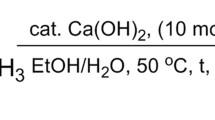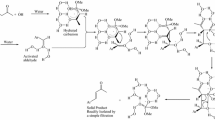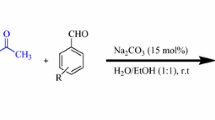Abstract
We performed the Rupe rearrangement of 1-ethynylcyclohexan-1-ol in near-critical water to study the reaction under high temperature conditions. The final product thus obtained was primarily 1-cyclohexen-1-ylethanone which was identified by GC-MS. The influences of reaction time, temperature, and initial reactant-to-water ratio on the yield of 1-cyclohexen-1-ylethanone were examined. The yield of 1-cyclohexen-1-ylethanone was 49 % in pure water at 260°C for a reaction time of 60 min. However, when additives such as ZnSO4, FeCl3, and NaHSO4, respectively, were introduced to the water to investigate the effect of salts on the Rupe rearrangement reaction, the yield increased markedly to as much as 88 % in 5 mole % NaHSO4 aqueous solution under the same conditions. The catalytic ability of the additives decreased in order: NaHSO4, FeCl3, ZnSO4. On the basis of these results, a possible reaction mechanism of the Rupe rearrangement of 1-ethynylcyclohexan-1-ol in near-critical water was proposed.
Similar content being viewed by others
References
An, J., Bagnell, L., Cablewski, T., Strauss, C. R., & Trainor, R W. (1997). Applications of high-temperature aqueous media for synthetic organic reactions. Journal of Organic Chemistry, 62, 2505–2511. DOI: 10.1021/jo962115k.
Anastas, P. T., & Warner, J. C. (1998). Green chemistry: Theory and practice. London, UK: Oxford University Press.
Ansell, M. F., Hancock, J. W., & Hickinbottom, W. J. (1956) The synthesis and reactions of branched-chain hydrocarbons Part X. The rearrangement of α-ethynyl alcohols to unsaturated carbonyl compounds. Journal of the Chemical Society, 192, 911–917. DOI: 10.1039/JR9560000911.
Connolly, J. F. (1966). Solubility of hydrocarbons in water near the critical solution temperatures. Journal of Chemical & Engineering Data, 11, 13–16. DOI: 10.1021/je60028a003.
Duan, P. G., Li, S., Yang, Y., Wang, Z. Z., & Dai, L. Y. (2009) Green medium for the hydrolysis of 5-cyanovaleramide Chemical Engineering & Technology, 32, 771–777. DOI: 10.1002/ceat.200800607.
Fraga-Dubreuil, J., & Poliakoff, M. (2006). Organic reactions in high-temperature and supercritical water. Pure and Applied Chemistry, 78, 1971–1982. DOI: 10.1351/pac200678111971.
Fukuda, Y., Shiragami, H., Utimoto, K., & Nozaki, H. (1991) Synthesis of substituted furans by palladium-catalyzed cyclization of acetylenic ketones. Journal of Organic Chemistry, 56, 5816–5819. DOI: 10.1021/jo00020a024.
Fukuda, Y., & Utimoto, K. (1991). Effective transformation of unactivated alkynes into ketones or acetals with a gold(III) catalyst. Journal of Organic Chemistry, 56, 3729–3731. DOI: 10.1021/jo00011a058.
Hassner, A., & Stumer, C. (1994). Organic syntheses based on name reactions and unnamed reactions. Oxford, UK: Pergamon.
Jerome, K. S., & Parsons, E. J. (1993). Metal-catalyzed alkyne cyclotrimerizations in supercritical water. Organometallics, 12, 2991–2993. DOI: 10.1021/om00032a022.
Katritzky, A. R., Allin, S. M., & Siskin, M. (1996). Aquathermolysis: Reactions of organic compounds with superheated water. Accounts of Chemical Research, 29, 399–406. DOI: 10.1021/ar950144w.
Katritzky, A. R., Luxem, F. J., & Siskin, M. (1990). Aqueous high-temperature chemistry of carbo- and heterocycles. 6 Monosubstituted benzenes with two carbon atom side chains unsubstituted or oxygenated at the α-position. Energy Fuels, 4, 518–524. DOI: 10.1021/ef00023a020.
Kruse, A., & Dinjus, E. (2007). Hot compressed water as reaction medium and reactant. Properties and synthesis reactions. Journal of Supercritical Fluids, 39, 362–380. DOI: 10.1016/j.supflu.2006.03.016.
Li, S., Chang, Y. J., Wang, Y., & Dai, L. Y. (2011). Research on hydration of phenylacetylene assisted with additives in nearcritical water. Chinese Chemical Letters, 22, 393–396. DOI: 10.1016/j.cclet.2010.11.003.
Marshall, W. L., & Franck, E. U. (1981). Ion product of water substance, 0–1000°C, 1–10,000 bars. New international formulation and its background. Journal of Physical and Chemical Reference Data, 10, 295–304. DOI: 10.1063/1.555643.
Parham, W. E., Wheeler, E. L., Dodson, R. M., & Fenton, S. W. (1954). The Rupe rearrangement of 2,6-dimethyl-2-carbethoxy-l-(phenylethynyl)-cyclohexanol (II) and 2,6-dimethyl-2-carbetoxy-l-(3-isopropylphenylethynyl)-cyclohexanol(III). Journal of the American Chemical Society, 76, 5380–5385. DOI: 10.1021/ja01650a038.
Parsons, E. J. (1996). Organic reactions in very hot water. ChemInform, 26, 30–34. DOI: 10.1002/chin.199643280.
Savage, P. E. (1999). Organic chemical reactions in supercritical water. Chemical Reviews, 99, 603–622. DOI: 10.1021/cr9700989.
Simoneit, B. R. T. (1995). Evidence for organic synthesis in high temperature aqueous media — facts and prognosis. Origins of Life and Evolution of Biospheres, 25, 119–140. DOI: 10.1007/BF01581578.
Siskin, M., Brons, G., Vaughn, S. N., Katritzky, A. R., & Balasubramanian, M. (1990). Aqueous organic chemistry. 3 Aquathermolysis: reactivity of ethers and esters. Energy Fuels, 4, 488–492. DOI: 10.1021/ef00023a014.
Smissmann, E. E., Johnsen, R. H., Carlson, A. W., & Aycock, B. F. (1956). The acid-catalyzed rearrangement of phenylethynylcarbinols. Journal of the American Chemical Society, 78, 3395–3400. DOI: 10.1021/ja01595a036.
Swaminathan, S., & Narayanan, K. V. (1971). Rupe and Meyer-Schuster rearrangements. Chemical Reviews, 71, 429–438. DOI: 10.1021/cr60273a001.
Torry, L. A., Kaminsky, R., Klein, M. T., & Klotz, M. R (1992). The effect of salts on hydrolysis in supercritical and near-critical water: Reactivity and availability. The Journal of Supercritical Fluids, 5, 163–168. DOI: 10.1016/0896-8446(92)90003-3.
Watanabe, M., Sato, T., Inomata, H., Smith, R. L., Jr., Arai, K., Kruse, A., & Dinjus, E. (2004). Chemical reactions of C1 compounds in near-critical and supercritical water. Chemical Reviews, 104, 5803–5822. DOI: 10.1021/cr020415y.
Weingärtner, H., & Franck, E. U. (2005). Supercritical water as a soluvent. Angewandte Chemie International Edition, 44, 2672–2692. DOI: 10.1002/anie.200462468.
Author information
Authors and Affiliations
Corresponding author
Rights and permissions
About this article
Cite this article
Chang, YJ., Wang, ZZ., Luo, LG. et al. Additive-assisted Rupe rearrangement of 1-ethynylcyclohexan-1-ol in near-critical water. Chem. Pap. 66, 33–38 (2012). https://doi.org/10.2478/s11696-011-0093-3
Received:
Revised:
Accepted:
Published:
Issue Date:
DOI: https://doi.org/10.2478/s11696-011-0093-3




